#nbwm
Explore tagged Tumblr posts
Note
Just wanted to share that I mentioned Going to Weather to my boss at the NBWM and she said that if you ever publish it in a physical book, the museum shop might be interested in selling it :)
Oh how delightful! Do let the NBWM know that I have a crush on them hahah.
If we ever get to that point in many, MANY a year, I shall certainly reach out lol.
23 notes
·
View notes
Photo

So, in Moby-Dick, written in 1851, Herman Melville claimed that nobody had ever drawn an accurate picture of a whale, and that it was impossible to do so; “Leviathan is that one creature in the world that must remain unpainted to the last.”
The Japanese of 1680 would like to call bullshit. This is not only an accurate image of a North Pacific Right Whale, easily identifiable against modern photographs, it is a work of art. Look how the artist has captured the sinuous power of the tail, the grace of the flukes, the tenderness with which the infant snuggles against its mother. And again, a work of scientific merit, showing the turbulence generated by the whale, the way the infant travels in the calm slipstream behind the flipper, and what I believe to be anatomical labels on both.
I stood staring at this scroll for some minutes, trying not to press my nose against the glass in a way that would make the docents kick me out. @otherhazards had the presence of mind to take a photograph.
100 notes
·
View notes
Photo

Thursday Night. (at Savvy Bistro & Bar) https://www.instagram.com/p/CenSny-NBWm/?igshid=NGJjMDIxMWI=
0 notes
Photo

at Colorado https://www.instagram.com/p/CM_wVz-nbwm/?igshid=bafz8honetal
0 notes
Text
iBanFirst Expands European Footprint with NBWM Acquisition
The acquisition will help NBWM’s existing clients, facilitating their ability to make cross-border payments iBanFirst Expands European Footprint with NBWM Acquisition syndicated from https://forexlasersforum.blogspot.com
0 notes
Video
youtube
(via https://www.youtube.com/watch?v=NBWm-8KU8d8)
0 notes
Note
hello! may i ask where you find places that have old records like sailors’/whalers’ journals and logs and things like that? i used to have institutional access through my college to some databases & such but since graduating i’m having trouble finding primary sources
Archive.org! There are hundreds digitized. Nicholson Whaling Collection from the Providence Public Library has the largest, followed by the New Bedford Whaling Museum. New Bedford Public Library, Nantucket Historical Society, and Martha’s Vineyard Museum have some. But PPL and NBWM are my heavy hitters when I want to find a wealth of them. If you search those institutions on that platform you’ll find their collections.
30 notes
·
View notes
Text
Patiently twiddling my thumbs waiting for the nbwm to digitize Five Specific Journals.
#IF IT WASN’T…some hours away and I hadn’t already spent a ton of money and I didnt have a cat I’d just#Go there for three days and read them onsite#BUT ALAS#I need them SOOO bad……..
8 notes
·
View notes
Note
So, 19th century whaling stuff huh? (purely on recommendation from a reblog from ltwilliammowett) Got any recommendations for visual references about the different kinds of whaling ship at the time? Looking for stuff that could of existed around the 1870s towards the 1890s
I’ll unpaywall a longish essay I wrote about a year ago on patreon about the general design of whaleships, that includes images as well as ship register lists that describe them. It’s written from the angle of design decisions I made for a graphic novel, but reading beyond the artmaking conversation I share information about how whalers tended to be shaped and the identifying features they carried.
For additional visual references I’d check out the photo collections of the New Bedford Whaling Museum and the Charles W. Morgan at Mystic Seaport. The photos from the NBWM are early 20th century, but the ships within them are older. Mid 19th century vessels were used well into the late part of the century and into the early 1900s with very little change, though by that point the industry was fully on its way out the door. The sketches in whaling logbooks or on scrimshaw are also a good way to get a sailor’s interpretation of the vessels. Whaleships and Whaling by Albert Cook Church and Sperm Whaling from New Bedford by Elton W Hall (that is a collection of Clifford Ashley’s photographs from his time on the whaler Sunbeam) are good visual books too. ANYWAY, onto the Essay under the readmore, if you’re so inclined.
Melville described Captain Ahab's ship the Pequod as having an “old-fashioned claw-footed look about her." It's a description I always hold in my mind whenever I draw a whaler. Melville, of course, added more whimsy to his iconic vessel, ‘a cannibal of a craft, tricking herself forth in the chased bones of her enemies’. With sperm whale teeth in the place of belaying pins, blocks made of sea-ivory instead of wood, and a whale’s jawbone in place of a tiller. While whalebone blocks and belaying pins were absolutely made on occasion, whaleships in general were not so unique from one another.
In looking at the long list of Ship Registers out of New Bedford, 1796-1850, it seems that if you saw one whaleship you more or less saw ‘em all.
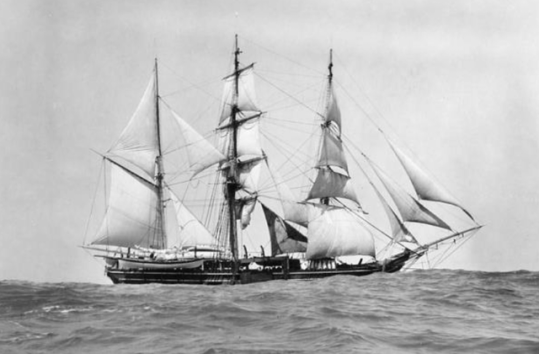
Photo of the bark Sunbeam hove to at sea, 1904, Clifford Ashley. Via New Bedford Whaling Museum.
Typically 19th century whaleships were three-masted ships or barks, and many ships were eventually re-rigged as barks in the latter half of the century as it required a smaller crew to handle. Whalers tended to be squat and broad, built for stability rather than speed. They were going to be at sea for years, with big cavernous holds for hundreds upon hundreds of barrels of oil, as well as equipment and provisions set to last many months without resupply. Thus, sturdiness was the primary focus in their design.

A cross section of the bark Alice Knowles from G.B. Goode's The Fisheries and Fishery Industry of the United States. Look at all that needed storage space!
With square sterns and a typical ratio of 1:4 for beam to length (as opposed to sleek merchant ships that often were more of a 1:6), describing them as a ‘tub’,--as many whalers grudgingly did when speaking of their floating home--is rather fitting (though perhaps a bit uncharitable). On average, whaleships were 100-115 ft in length, 25-30ft wide, with a tonnage ranging from 180-400.
They were built with few frills. Rarely did they have galleries or figureheads, instead having a simple billet-head or doing without the flourish entirely. My biggest indulgence was giving the Valor a bit more of an elegant prow, which I might regret a little bit since now I have to draw it all the time.
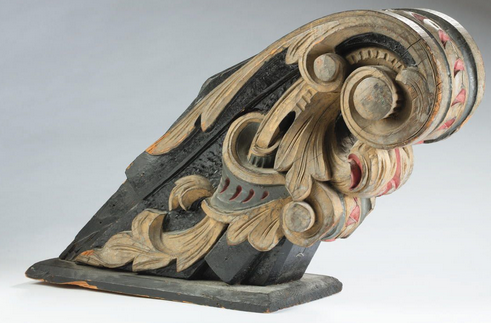
Billet-head vs figurehead...

A distinct lack of fanciness!
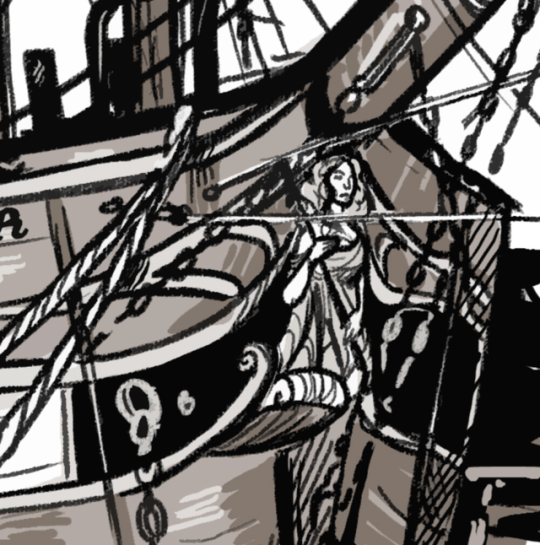
I wanted to draw a lady tho. The one of……three women in GTW. Does she count?
Sometimes whalers were painted with false gun ports along their hull, a traditional holdover from when they had to worry more often about wartime enemies in the late 18th century. The hope was that the paint job in combination with her chunky appearance would lead to her being mistaken for a small warship at a distance and thus spared harassment. Even when no longer really necessary, the design often made its appearance.
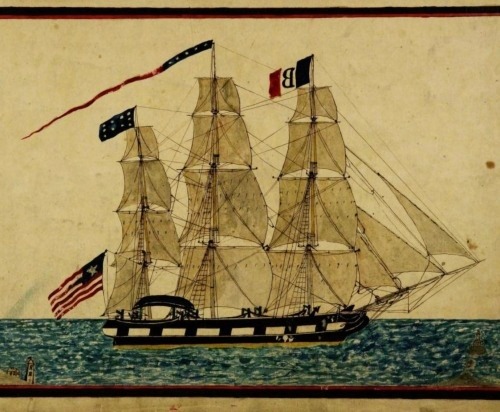
Drawing in the logbook of Captain James Coffin of his ship Washington, 1841.
I quite liked the look of the psuedo gun ports, and decided to give the Valor the same as an embellishment for some extra contrast.
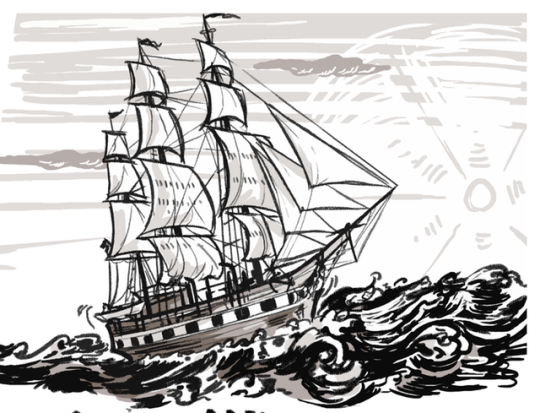
The most identifying feature of a whaler was the tryworks��a large brick oven with heavy iron pots located aft of the foremast and in front of the main hatch. They were built with a pen that would be filled with sea water that flowed freely beneath a checker-board laid brick base to keep the extreme heat from setting fire to the ship. The tryworks would have to be rebuilt for each voyage, so there was sometimes a rather joyous moment at the end of a long trip when the crew would tear the structure apart and toss it in the sea.
Along the port side, three whaleboats would be slung on the davits. Fore, aft, and amidships. A fourth whaleboat would be located on the starboard quarter.

Screenshot of my desktop background that's some deck plans of a whaleship cos I got sick of digging for the reference every time I had to spatially orient myself when drawing a panel!
Deckhouses were built aft to house the galley and storage lockers, and there was also a ‘hurricane house’ built over the helm to protect whoever was steering during foul weather. Spare whaleboats, as well as harpoons, spades, lances, and other whaling gear would be stored on top of this cover or on hanging shelves beneath it.
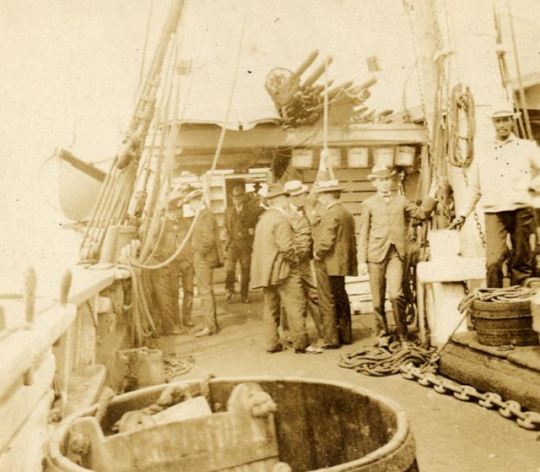
A view of whalers and the afthouse, on the bark Greyhound. Via NBWM.
The final identifying feature of a whaleship was a pair of cross trees, a platform with hoops at the top of the mast where men would be stationed to look out for whales.

The ship that I’ve referenced the most in my design of the Valor is, of course, the Charles W. Morgan because she can still be visited! The last surviving wooden whaleship, she had a long life of 37 voyages (and a couple movie roles in her sunset years) spanning from 1841-1921 (and one more voyage in 2014! Heartbreak of heartbreaks that I was not on it!). She’s now a crown jewel at the Mystic Seaport Museum. I was honored to meet her.
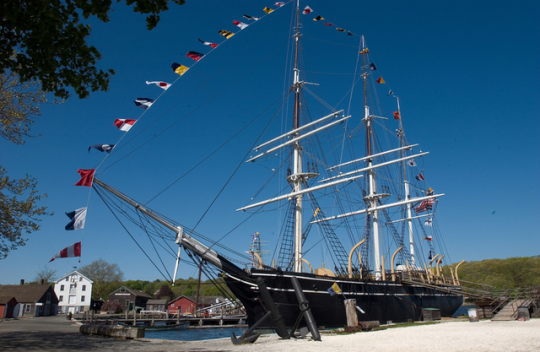
She had some lovely authenticating details that I was happy to put into my own worldbuilding, such as a reference to this gimballed bed. It was designed to always stay level even as the ship rolled, installed by one of the Morgan’s captains to try mitigating his wife's seasickness.
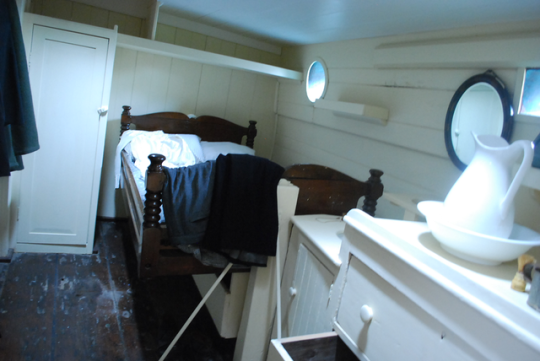

Another favorite detail of mine was how natural daylight was drawn into the cabins and forecastle via deck prisms. Set with their bases flush with the deck above, glass deck prisms were designed to bring light down below.
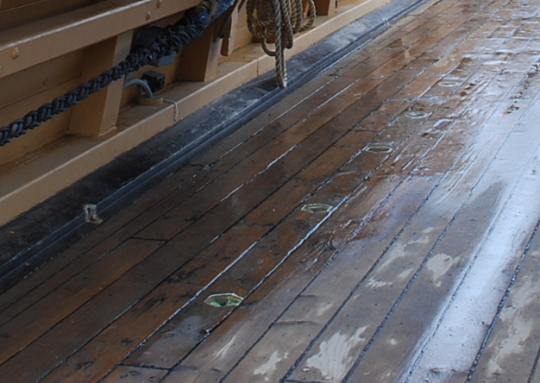
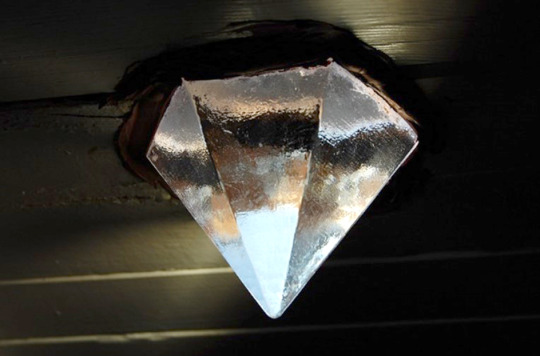
I remember being surprised at how effective they were. In the photo below, the yellow light is artificial, but the blue light is coming solely from the deck prism. This was on a dark rainy day.

As such, I really enjoy always thinking about how these prisms are lighting the areas below on the Valor.

During my visit I remember thinking that this old surviving whaleship looked quite comfortable and cozy.

Look at that.

Such homey little flourishes.
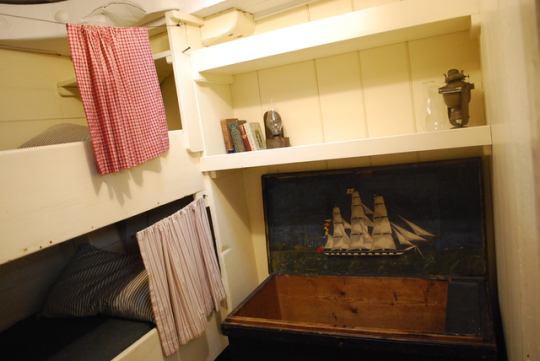
Look at how cute.
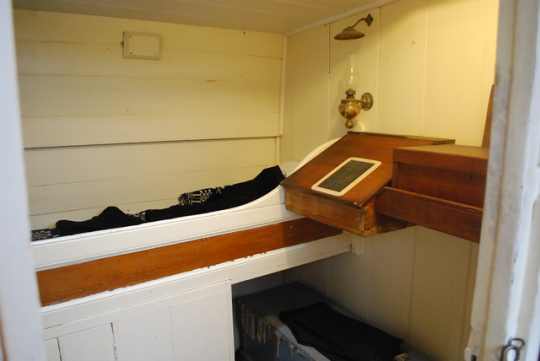
I’d live here.
That is, until I thought about the reality of this work and world. The fo'c'sle helped bring that reality forward. There wasn't anyone else on the ship and it was a cold spring day, but upon stepping into the space I could feel the humidity that had gathered there.

I could imagine the noise of it, the smell of it, the heaviness of the air that came with 20 men sharing such a space, eating and smoking in it, crushing cockroaches in it, dumping their wet gear in it, vomiting in it, keeping a communal urine barrel in it, reeking of blood and oil and smoke and ash as everything mouldered in the damp for for three to four years. The dimensions of the fo'c'sle was enough to set my imagination a’going. It was a perfect reference, and for the comic it just needed to be populated.
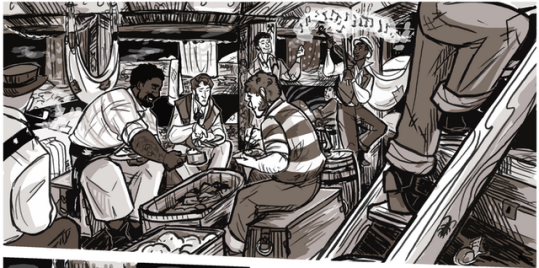
For the sake of having somewhat readable panels, my boys are lucky to have been given a much more spacious residence. But still, I try to build out the claustrophobia of the space. And this is just the first night. As time goes on, I’m looking forward to besmirching this place.
Superimposing the reality of a whaler was also necessary in drawing the decks (and will become even more so when I get to the whaling scenes). Now, as a museum, the ship is pristine...
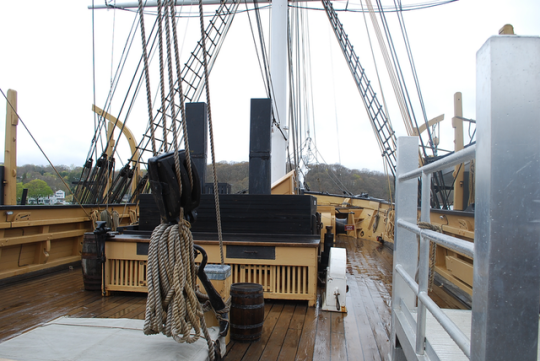
But I must always remember the description given by a 19th century whaler grumbling that while cutting in a whale, ‘everything is beshit’. Documentary footage as well as photographs, coupled with the words from dead men's journals and one’s own imagination of the hellishness of the work is how I begin to paint the decks of this whaler, especially during the work of cutting in.
(warning for sensitive images below of a lot of blubber)


Photos by William H Tripp, 1925. Via NBWM
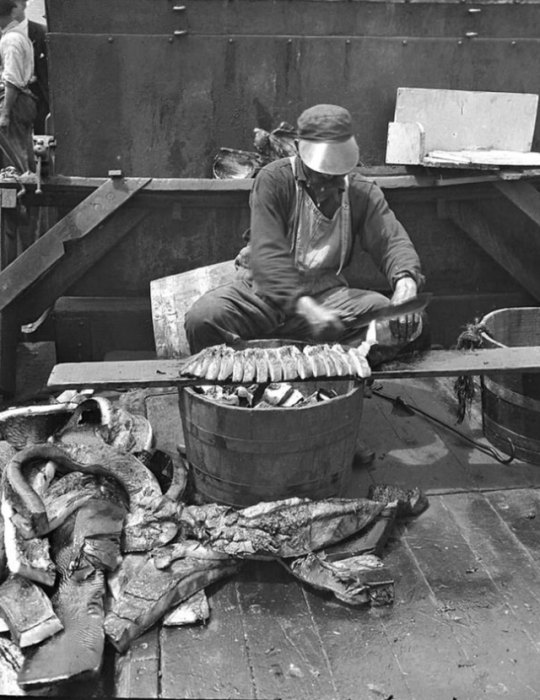
Photo by Albert Cook Church. NBWM.
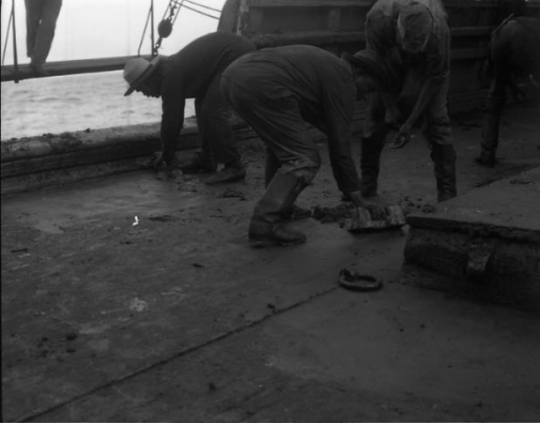
This 1904 image, as described by its photographer Clifford Ashley, 'Rectangular blocks of blubber (lippers) are used to scrape up bits of blubber and slush from the deck so nothing is wasted'. Via NBWM.
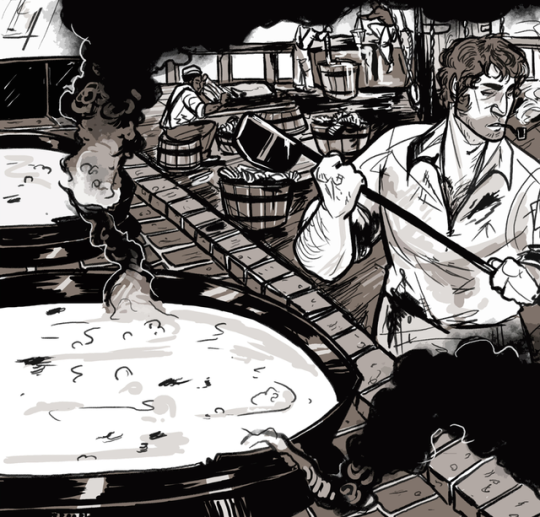
But the place that made me feel the closest sense of reality on the Morgan was the blubber room. The deck prisms didn’t reach here, and in some places the beams were so low I had to duck my head.
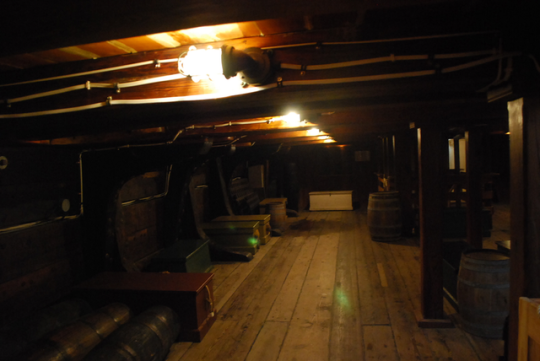
This was where large 15ft sheets of blubber would be dumped below via the hatch, for men to hack them up into smaller 6ft ‘horse pieces’ and then pitch them back up on deck to be further minced. I couldn’t help but think of the movement of the ship in the dark, of the slabs of blubber filling the space, slick with oil. I thought of how much oil would be tracked across the deck and how slippery it’d be, and how a man would have to keep his head cocked to one side for hours to work in there. I thought of how he would get to the fo'c'sle through the blubber room and how the work would be tracked all over the ship and find its way into every bunk. How it would be absolutely inescapable. I thought about the hot sick closeness of having no air down there, the heat from the tryworks radiating mercilessly from above, a crick in your neck, your double-edged boarding knife handle too slick.
Being there and overlaying that work within it was one of the closest times I felt to time travel. And as I try to make the Valor feel alive, to feel real, I always try to capture what I felt here in every panel, and push each one just a little more to get as close as I can to that place.
28 notes
·
View notes
Photo


More from the New Bedford Whaling Museum. I learnt a great deal about whale anatomy.

29 notes
·
View notes
Text

Another splendid Japanese print of a whale. This one is more cartoony, but I believe that it is indeed a cartoon. A comic strip, even!
Reading the image right to left, you see that the boat flying French colours has just upstaged the Polish boat and struck the whale with the first harpoon. That whale is now theirs under international whaling law.
Moving to the middle panel, even with the simple lines, you can see the men in the Japanese boat are hopping mad. I do not know the Japanese for "you dirty rotten son of a bitch," but I am certain that the man standing up in the middle has just taught it to all present.
Having arrived too late for a chance at the whale, the men in the left-hand panel are content to point and laugh at the Japanese. One of the boats flies the British flag, but I haven't the faintest about the other and would welcome comments.
Another thing I like about this print is that it shows ethnocentrism from outside my own ethnicity, which is always a fun and educational perspective. The boats are flying assorted European flags, but on Japanese flagpoles, flown from Japanese whaleboats, and all the whalers are dressed in Japanese kilt-like items (again, if you know wtf these are, please tell me). The artist clearly figured that if you've seen one whale crew, you've seen them all. It reminds me of early Asian pictures of Europeans, who are depicted as basically Asian people with huge noses.
20 notes
·
View notes
Photo

Another Japanese whaling scroll! @otherhazards had to photograph it in bits, and I’m going through them right-to-left to preserve the narrative structure. This first image shows shore whaling- instead of going out in a huge ship to hunt the whales, they wait until a whale is sighted offshore, then jump in small, agile boats and paddle like mad out to try and harpoon it. This Japanese variation shows something I haven’t read about in Western shore whaling- there are two boats towing a net around the whales to stop them heading out into open sea. This is a bold tactic, and the netters would have to row faster than anyone else.

This next panel shows what happens when they’ve killed a whale- some people begin flensing off the blubber even as it is being towed into shore by gangs of men heaving at capstans.

Finally, the whale is brought onshore for continued processing. If you notice the man standing up in back just to the right of centre, you’ll see he’s carrying a long-handled flensing knife- practically a spear- that is virtually identical to the one on display that was made in 1976. Other people are carrying slabs of blubber and other whale hunks off for further processing in a building just out of frame.
18 notes
·
View notes
Photo

@otherhazards and I went to the New Bedford Whaling Museum, because I recently read Moby-Dick and am experiencing New Fandom Glee. There was so much more to the museum than Melville worship, though.

There was literally too much to see, and I’m going to have to break what we did see into several posts.
10 notes
·
View notes
Text
One thing about Covid is the realization that every place and institution you loved….probably behaved badly when it came down to money vs workers. I’m sure there are maybe some out there that didn’t but…
#I’m very fond of the nbwm but I’m like ‘…I’m sure they behaved badly’#I don’t have any inside scoop on that but going by museums in general….#the place I’m at people love…but it behaved badly#independent stores I loved…behaved badly
91 notes
·
View notes